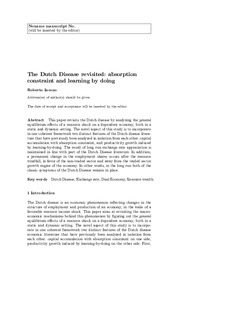| dc.contributor.author | Iacono, Roberto | |
| dc.date.accessioned | 2017-10-16T11:15:16Z | |
| dc.date.available | 2017-10-16T11:15:16Z | |
| dc.date.created | 2017-10-12T12:18:28Z | |
| dc.date.issued | 2017 | |
| dc.identifier.issn | 1617-982X | |
| dc.identifier.uri | http://hdl.handle.net/11250/2460278 | |
| dc.description.abstract | This paper revisits the Dutch disease by analyzing the general equilibrium effects of a resource shock on a dependent economy, both in a static and dynamic setting. The novel aspect of this study is to incorporate in one coherent framework two distinct features of the Dutch disease literature that have previously been analyzed in isolation: capital accumulation with absorption constraint, and productivity growth induced by learning-by-doing. The result of long run exchange rate appreciation is maintained in line with part of the Dutch Disease literature. In addition, a permanent change in the employment shares occurs after the resource windfall, in favor of the non-traded sector and away from the traded sector growth engine of the economy. In other words, in the long run both of the classic symptoms of the Dutch Disease remain in place. | nb_NO |
| dc.language.iso | eng | nb_NO |
| dc.publisher | Springer Verlag | nb_NO |
| dc.title | The Dutch disease revisited: absorption constraint and learning by doing | nb_NO |
| dc.type | Journal article | nb_NO |
| dc.description.version | submittedVersion | nb_NO |
| dc.source.journal | Portuguese Economic Journal | nb_NO |
| dc.identifier.doi | 10.1007/s10258-017-0137-x | |
| dc.identifier.cristin | 1504112 | |
| dc.description.localcode | © Springer Verlag. The final publication is available at https://link.springer.com/article/10.1007%2Fs10258-017-0137-x. This is the authors' submitted manuscript to the article. | nb_NO |
| cristin.unitcode | 194,60,20,0 | |
| cristin.unitcode | 194,67,90,0 | |
| cristin.unitname | Institutt for samfunnsøkonomi | |
| cristin.unitname | Institutt for sosialt arbeid | |
| cristin.ispublished | false | |
| cristin.fulltext | preprint | |
| cristin.qualitycode | 1 | |
